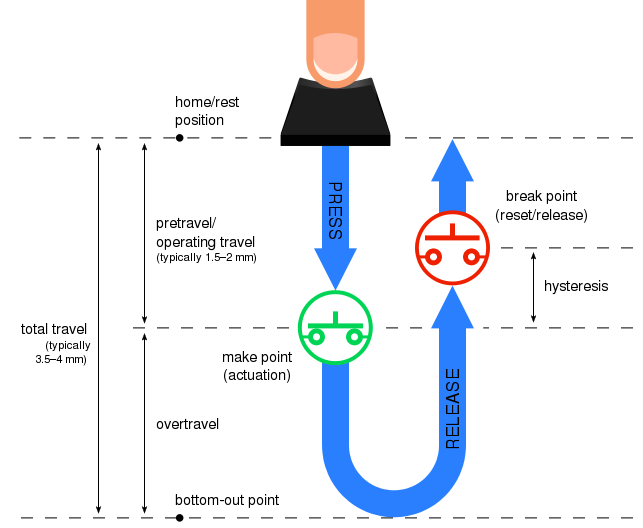Difference between revisions of "Travel"
(There's probably more to say, but now this gets its own page with a pretty picture) |
(Couple of clarifications) |
||
| Line 12: | Line 12: | ||
==Overtravel== | ==Overtravel== | ||
| − | Overtravel refers to the travel of the switch from the point of actuation to full travel. The total travel of a switch comprises the pretravel plus the overtravel. Various techniques are available to provide an overtravel region. For example, [[foam and foil]] switches actuate when the foil disc reaches the PCB; above the disc is | + | Overtravel refers to the travel of the switch from the point of actuation to full travel. The total travel of a switch comprises the pretravel plus the overtravel. Various techniques are available to provide an overtravel region. For example, [[foam and foil]] switches actuate when the foil disc reaches the PCB; above the disc is a foam "overtravel pad" (hence "foam and foil"), that allows the switch to keep moving even though the disc has reached the PCB. The foam compresses, allowing the key to be pressed further after the foil disc reaches the PCB. |
| − | The bridge contact system in [[RAFI RS 76 M (illuminated)]] also permits the [[slider]] to continue moving beyond the point that the contacts close. | + | The bridge contact system in [[RAFI RS 76 M (illuminated)]] also permits the [[slider]] to continue moving beyond the point that the contacts close. The movable contact strip is supported from above by spring, so that the slider can continue moving after movable contact strip reaches the stationary contacts. |
[[Stacked spring]] switches include overtravel region by way of triggering a second spring, or a dome, to snap into place under spring pressure before the slider has come to a stop. | [[Stacked spring]] switches include overtravel region by way of triggering a second spring, or a dome, to snap into place under spring pressure before the slider has come to a stop. | ||
Revision as of 11:02, 7 February 2017
Travel refers to the vertical motion of a key.
Total travel
The total travel of a switch is the distance between the key's resting position, and its position when fully depressed, i.e. how far down you can press the key. In typical desktop keyboards, the total travel is between 3 and 4 mm; keyboards with total travel in this range or above are referred to as "full-travel". "Full-travel" is not formally defined, however; RAFI define "full-travel" as being 2.5 mm or more, which is the total travel of the smaller switches in the RAFI full-travel key switch family.
Short travel keyboards, like laptop ones, have a travel of about 2–2.5 mm.
Pretravel
In most switch types except standard rubber dome over membrane keyboards, a switch will actuate before it is bottomed out. The terms "pretravel" and "operating travel" refer to how far down the key must be pressed for it to actuate. Pretravel is typically around of half travel. Once the pretravel has been reached, the operator is free to let go of the key without needing to press it all the way down.
Overtravel
Overtravel refers to the travel of the switch from the point of actuation to full travel. The total travel of a switch comprises the pretravel plus the overtravel. Various techniques are available to provide an overtravel region. For example, foam and foil switches actuate when the foil disc reaches the PCB; above the disc is a foam "overtravel pad" (hence "foam and foil"), that allows the switch to keep moving even though the disc has reached the PCB. The foam compresses, allowing the key to be pressed further after the foil disc reaches the PCB.
The bridge contact system in RAFI RS 76 M (illuminated) also permits the slider to continue moving beyond the point that the contacts close. The movable contact strip is supported from above by spring, so that the slider can continue moving after movable contact strip reaches the stationary contacts.
Stacked spring switches include overtravel region by way of triggering a second spring, or a dome, to snap into place under spring pressure before the slider has come to a stop.
Actuation and reset points
The actuation point in a keyboard switch is the point at which the switch registers a key press. Similarly, the reset point is when the key ceases to register the key press. In some descriptions, the actuation point may be referred to as the "make" or "operating" point. The reset point may also be referred to as the "break" point.
In metal contact switches (including reed switches), physical metal contacts close and pass current.
Hysteresis
In many switch designs, the actuation and reset point do not occur at the same place in the key travel. Instead, the reset point occurs higher up in travel than the actuation point. The gap between these points is referred to as the hysteresis, or lost motion. Hysteresis prevents some repeated keystrokes from occurring, but not all.
The hysteresis of the Cherry MX Blue switch is quite pronounced due to its design, and this means it becomes harder to rapidly press a key multiple times in a row ('double tap'). This makes it less suitable for playing certain types of games.
